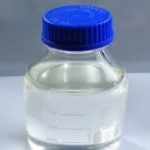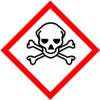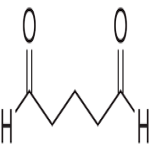CAS Number 111-30-8, Glutaraldehyde Concentrate or Solution USP BP Ph Eur FCC Food Grade Manufacturers Exporters







CAS Number 111-30-8, Glutaraldehyde Concentrate or Solution Manufacturer Exporter
For Properties Specifications of Glutaraldehyde Concentrate or Solution Click Properties, Specifications of Glutaraldehyde Concentrate or Solution Manufacturer.
For Uses of Glutaraldehyde Concentrate or Solution Click Uses of Glutaraldehyde Concentrate or Solution Manufacturer.
For For SDS MSDS Sheet of Glutaraldehyde Concentrate or Solution Click SDS Safety Data Sheet MSDS Sheet of Glutaraldehyde Concentrate or Solution Manufacturer.
The Properties and Specifications of Glutaraldehyde Concentrate or Solution:
Glutaral Concentrate USP Grade Specifications:
C5H8O2 100.12
Pentanedial; Glutaraldehyde CAS 111-30-8
DEFINITION
Glutaral Concentrate is a solution of glutaraldehyde in Purified Water. It contains NLT 100.0% and NMT 104.0% of the labeled amount of glutaral (C5H8O2 ). The labeled amount is 50.0 g of C5H8O2 per 100 g of Concentrate.
IDENTIFICATION
A.
Solution A: Add 4 mL of sulfuric acid to 0.8 g of 2,4-dinitrophenylhydrazine, then add 6 mL of water, dropwise, with swirling. When dissolution is essentially complete, add 20 mL of alcohol, and filter. The filtrate is the 2,4-dinitrophenylhydrazine reagent.
Analysis: Add 0.4 mL of Concentrate to 20 mL of Solution A, mix by swirling, and allow to stand for 5 min. Collect the precipitate on a filter, and rinse thoroughly with alcohol. Dissolve the precipitate in 20 mL of hot ethylene dichloride, filter, and cool the filtrate in an ice bath until crystallization occurs. Collect the precipitate on a filter. Redissolve the precipitate by refluxing with 30 mL of acetone, filter, and cool the filtrate in an ice bath until crystallization occurs. Collect the precipitate on a filter.
Acceptance criteria: The 2,4-dinitrophenylhydrazone so obtained melts at 185C –195C, within a 3C range.
ASSAY: To pass the test.
Acidity:
Analysis: Transfer 60.0 g to a conical flask, add phenolphthalein TS, and titrate with 0.10 N alcoholic potassium hydroxide to a pink endpoint that is permanent for NLT 15 s.
Acceptance criteria: NMT 40 mL of 0.10 N potassium hydroxide is consumed, corresponding to NMT 0.4% (w/w) of acid, calculated as acetic acid.
pH: 3.7–4.5
Clarity of Solution:
Analysis: Transfer 5.0 mL of Concentrate to a glass-stoppered, 100-mL graduated cylinder, add water to obtain 100 mL of mixture, insert the stopper, and mix by inverting the graduated cylinder several times. Allow the bubbles to rise and view downward through the solution against a dark background.
Acceptance criteria: The solution is clear.
Strong Glutaraldehyde Solution BP Ph Eur Grade Specifications:
C5H8O2 --- 100.1 --- CAS 111-30-8
DEFINITION
Strong Glutaraldehyde Solution is an aqueous solution of glutaraldehyde (pentanedial). It contains not less than 47.0% and not more than 53.0% w/w of glutaraldehyde, C5H8O2.
CHARACTERISTICS
A colourless or almost colourless solution.
IDENTIFICATION
A. Heat 1 mL with 10 mL of a solution containing 1 g of hydroxylamine hydrochloride and 2 g of sodium acetate in water on a water bath for 10 minutes, allow to cool and filter. The melting point of the residue, after washing with water and drying at 105C, is about 178C.
B. Add 0.05 mL to 2 mL of ammoniacal silver nitrate solution and mix gently for a few minutes. Silver is deposited.
TESTS
Acidity: Dilute 10 mL with 10 mL of carbon dioxide-free water and titrate with 0.1M sodium hydroxide VS using bromothymol blue solution as indicator. Not more than 5.0 mL of 0.1M sodium hydroxide is required to change the colour of the solution.
Clarity and colour of solution: Dilute 1 volume with 4 volumes of water. The resulting solution is clear, and not more intensely coloured than reference solution.
Weight per mL: 1.126 to 1.134 g.
Glutaraldehyde Solution BP Ph Eur Specifications:
DEFINITION
Glutaraldehyde Solution is a dilution of Strong Glutaraldehyde Solution in a mixture of Purified Water and Ethanol (96 per cent).
In making Glutaraldehyde Solution, Ethanol (96 per cent) may be replaced by Industrial Methylated Spirit.
Content of glutaraldehyde, C5H8O2: 9.2 to 10.5% w/v.
IDENTIFICATION
A. Heat 5 mL with 10 mL of a solution containing 1 g of hydroxylamine hydrochloride and 2 g of sodium acetate on a water bath for 10 minutes, allow to cool and filter. The melting point of the residue, after washing with water and drying at 105C, is about 178C, Appendix V A.
B. To 1 mL add 2 mL of ammoniacal silver nitrate solution and mix gently for a few minutes. Silver is deposited.
TESTS
Ethanol content: 50 to 60% v/v.
Glutaraldehyde FCC Food Grade Speifications:
Glutaral; 1,5-Pentanedial
C5H8O2 Formula weight 100.12
CAS: 111-30-8
DESCRIPTION
Glutaraldehyde occurs as a clear, nearly colorless, aqueous solution. It is miscible with water. The grades of Glutaraldehyde suitable for food use usually have concentrations between 15% and 50%.
Function: Fixing agent in the immobilization of enzyme preparations; cross-linking agent for microencapsulating flavoring substances; antimicrobial for sugar milling.
REQUIREMENTS
Identification: 2,4-Dinitrophenylhydrazine Reagent Add 4 mL of sulfuric acid to 0.8 g of 2,4-dinitrophenylhydrazine, then while swirling, add 6 mL of water, dropwise. When dissolution is essentially complete, add 20 mL of alcohol, mix, and filter. The filtrate is the reagent.
Procedure Add 0.4mLof sample to 20mLof 2,4-Dinitrophenylhydrazine Reagent. Mix by swirling and allow the mixture to stand for 5 min. Collect the precipitate on a filter, and rinse thoroughly with alcohol. Dissolve the precipitate in 20 mL of hot ethylene dichloride, filter, and cool the filtrate in an ice bath until crystallization occurs. Collect the precipitate on a filter. Redissolve the precipitate by refluxing with 30 mL of acetone, filter, and cool the filtrate in an ice bath until crystallization occurs. Collect the precipitate on a filter. The 2,4-dinitrophenylhydrazone so obtained melts between 185C and 195C.
Assay: Not less than 100.0% and not more than 105.0% of the labelled amount of C5H8O2.
Lead: Not more than 2 mg/kg.
pH: Between 3.1 and 4.5.
The Uses of Glutaraldehyde Concentrate or Solution:
Glutaraldehyde or Glutaric acid dialdehyde is a disinfectant, medication, preservative, and fixative. As a disinfectant, it is used to sterilize surgical instruments and other areas of hospitals. As a medication, it is used to treat warts on the bottom of the feet. Glutaraldehyde is effective against a range of microorganisms including spores. There are several other commercial uses such as leather tanning, hydraulic fracturing, industrial water treatment etc. Glutaraldehyde CH2(CH2CHO)2 is a pungent colorless oily liquid. It is mainly available as an aqueous solution. Glutaraldehyde is used widely as a cold sterilant to disinfect a variety of heat-sensitive instruments.
\The MSDS-SDS Hazard Statement of Glutaraldehyde Concentrate or Solution:
Glutaraldehyde Solution SDS, Safety Data Sheet
MSDS Sheet, Material Safety Data Sheet 11-Jan-23
1. Product Identification
Product Name & Other Names: Glutaraldehyde Solution or Pentanedial or Glutardialdehyde or Glutaric acid dialdehyde or Glutaric aldehyde or Glutaric dialdehyde, 1,5-Pentanedial (for un-diluted material).
CAS No.: 111-30-8
EINECS EC Code: 203-856-5
Molecular Weight: 100.12 for un-diluted material.
Chemical Formula: CH2(CH2CHO)2 for un-diluted material.
Relevant uses and uses advised against (if any): Oil & Gas Wells fracturing and Industrial Manufacturing.
2. Hazards Identification
GHS, Globally Harmonized System Classification in accordance with 29 CFR 1910
Classification according to Regulation (EC) No 1272/2008
Corrosive to Metals (Category 1), H290
Acute toxicity, Oral (Category 3), H301
Acute toxicity, Inhalation (Category 3), H331
Acute toxicity, Dermal (Category 4), H315
Skin corrosion (Category 1B), H312
Serious eye damage (Category 1), H318
Respiratory sensitization (Category 1) H334
Skin sensitization (Category 1), H317
Hazardous to the aquatic environment, acute hazard (Category 1), H400
Labeling according to GHS USA & Regulation (EC) No 1272/2008
GHS Label Elements  Toxic |
GHS Label Elements |
GHS Label Elements |
GHS Label Elements |
Signal Word: Danger
Hazard Statements:
H290: May be corrosive to metals
H301: Toxic if swallowed
H312: Harmful in contact with skin.
H315: Causes skin irritation.
H317: May cause an allergic skin reaction
H318: Causes serious eye damage.
H331: Toxic if inhaled
H334: May cause allergy or asthma symptoms or breathing difficulties if inhaled
H400: Very toxic to aquatic life.
Precautionary Statements
P220: Keep/Store away from clothing/other combustible materials.
P221: Take any precaution to avoid mixing with combustibles.
P234 Keep only in original container.
P260: Do not breathe dust/fume/gas/mist/vapors/spray.
P264: Wash ... thoroughly after handling.
P270: Do not eat, drink or smoke when using this product.
P271: Use only outdoors or in a well-ventilated area.
P272: Contaminated work clothing should not be allowed out of the workplace
P273 Avoid release to the environment.
P280-Wear protective gloves/protective clothing/eye protection/face protection.
P284 Wear respiratory protection.
P301+P310+330: IF SWALLOWED: Rinse mouth and immediately call a POISON CENTER or doctor/physician.
P302+P352: IF ON SKIN: Wash with soap and water.
P303+P361+P352: IF ON SKIN (or hair): Remove/Take off immediately all contaminated clothing. Wash with plenty of soap and water.
P304+P340: IF INHALED: Remove victim to fresh air and keep at rest in a position comfortable for breathing.
P304+P341+P311: IF INHALED: If breathing is difficult, remove to fresh air and keep at rest in a position comfortable for breathing. Call a POISON CENTER or doctor/physician.
P305+P351+P338: IF IN EYES: Rinse cautiously with water for several minutes. Remove contact lenses, if present and easy to do. Continue rinsing.
P332+P313: If skin irritation occurs: Get medical advice/attention.
P310 Immediately call a POISON CENTER or doctor/physician.
P314: Get Medical advice/attention if you feel unwell.
P330: If swallowed, rinse mouth.
P337+P313 If eye irritation persists: Get medical advice/ attention.
3. Composition/Information on Ingredients
Ingredient: Glutaraldehyde 13-17% in water.
CAS Number: 111-30-8
EINECS EC Code: 203-856-5
4. First Aid Measures
Always seek medical attention after first aid measures are provided.
Inhalation: If Glutaraldehyde is inhaled, it will cause irritation and damage to nose and throat. It can cause headache, bleeding from nose coughing and chest discomfort. Remove the victim to fresh air. If not breathing, give artificial respiration. If breathing is difficult, give oxygen. Get medical attention.
Ingestion: It will cause irritation and burns to mouth, digestive tract and stomach. It may lead to pain, nausea, vomiting, and even collapse. Contact medical center quickly. Never give anything by mouth to an unconscious person. Get medical attention.
Skin Contact: On contact, it can cause itching, pain, swelling and redness. Immediately flush skin with plenty of water for at least 15 minutes. Remove contaminated clothing and shoes. Get medical attention. Wash clothing before reuse. Thoroughly clean shoes before reuse.
Eye Contact: It can cause severe damage to eyes. Check for and remove any contact lenses. Immediately flush eyes with running water for at least 15 minutes, keeping eyelids open. Cold water may be used. Get medical attention.
5. Fire Fighting Measures
Fire: Flash point: NA.
Auto ignition temperature: NA
Toxic fumes, carbon dioxide and carbon monoxide may be formed in fire.
Fire Extinguishing Media: Dry chemical, foam or carbon dioxide and water spray jet.
Special Information: In the event of a fire, wear full protective clothing and NIOSH-approved self-contained breathing apparatus with full face piece operated in the pressure demand or other positive pressure mode.
6. Accidental Release Measures
Personal precautions, protective equipment, and emergency procedures: Avoid breathing dust/fumes/gas/mist/vapors/spray. Use individual protective equipment (waterproof boots, suitable protective clothing, safety glasses, etc.). Do not approach facing the wind.
Environmental precautions: Do not let the product enter drains, soil, or water sources.
Methods and materials used for containment Cleanup procedures and Storage: Avoid mist formation. Keep away from heat. Keep away from sources of ignition. The concentration of Glutaraldehyde can be brought down by neutralizing with 1.25 moles of Diammonium Phosphate. Do not inhale dust, vapors, mist, or gas. Avoid dust formation. Contain spilled material. Cover with an inert, non-combustible absorbent material, (e.g. sand, earth, diatomaceous earth, vermiculite). Use a shovel to put the material into a convenient waste disposal container. Finish cleaning by spreading water on the contaminated surface and allow to evacuate as per law.
7. Handling and Storage
Precautions for safe handling: Apply according to good manufacturing and industrial hygiene practices. Ensure proper ventilation. In case of insufficient ventilation, wear suitable respiratory equipment. Wash thoroughly after handling. Do not drink, eat, or smoke while handling. Avoid contact with skin, eyes, and clothing. Minimize dust generation. Avoid breathing dust/fumes/gas/mist/vapors/spray. Keep container tightly closed. Avoid ingestion and inhalation. Use individual protective equipment (waterproof boots, suitable protective clothing, safety glasses, etc.).
Conditions for safe storage, including any incompatibilities: Store in cool, dry, and ventilated area away from heat sources and protected from sunlight in tightly closed original container. Keep air contact to a minimum. Store protected from heat, sparks and ignition sources and incompatible materials. Avoid contact with skin and eyes. Avoid inhalation of dust/mist/vapor. Do not store with incompatible materials like metals, strong acids & alkalis, oxidizing & reducing agents. Do not allow to freeze. Avoid contact. Do not store near food items or near Diammonium Phosphate.
8. Exposure Controls/Personal Protection
Airborne Exposure Limits: TWA: Long term (8 hours) & Short term(15 minutes) WEL is 0.05 ppm.
Ventilation System: A system of local and/or general exhaust is recommended to keep employee exposures as low as possible.
Personal Respirators (NIOSH Approved): For conditions of use where exposure to the substance is apparent and engineering controls are not feasible, consult an industrial hygienist.
Skin Protection: Wear impervious protective clothing, including boots, gloves, lab coat, apron or coveralls, as appropriate, to prevent skin contact.
Eye Protection: Use chemical safety goggles and/or a full face shield where splashing is possible. Maintain eye wash fountain and quick-drench facilities in work area.
Other Control Measures: Maintain good housekeeping in work area. Handle in accordance with good industrial hygiene and safety practice.
9. Physical and Chemical Properties
Appearance: Colorless liquid.
Odor: Typical aldehyde smell.
Odor threshold: Not available.
pH: Not available.
Relative density: 1.025 approximate.
Melting point/freezing point: Not available.
Boiling Point: >100C
Flash point: Not available.
Auto-ignition temperature: Not available.
Decomposition temperature: Not available.
Upper/lower flammability or explosive limits: Not available.
Vapor pressure: Not available.
Vapor density: Not available.
Evaporation rate: Not available.
Flammability (solid, gas): Not available.
Partition coefficient: n-octanol/water: Not available.
Solubility: miscible with water
Viscosity: Not available.
10. Stability and Reactivity
Stability: Glutaraldehyde is stable under ordinary conditions of use and storage.
Hazardous Decomposition Products: Carbon dioxide, carbon monoxide and toxic fumes may form when heated to decomposition.
Hazardous Polymerization: Not reported.
Incompatibilities: Metals, strong acids & alkalies, oxidizing & reducing agents, heat and sparks.
Conditions to Avoid: Heat, flames, ignition sources and incompatibles.
11. Toxicological Information
Oral rat LD50: 134 mg/kg.
Carcinogenicity: No component of this product present at levels greater than or equal to 0.1% is identified as possible or confirmed human carcinogen by IARC, ACGIH, OSHA and NTP.
Mutagenic Effects: Not available.
Developmental Toxicity: Not available.
Reproductive Effects: No information available.
12. Ecological Information
Environmental Toxicity: Toxic to fish and aquatic life.
Persistence and Degradability: The product is easily biodegradable.
Mobility: Likely to be mobile due to water solubility.
Bioaccumulation/ Accumulation: No information available.
Results of PBT and vPvB assessment: No data available for assessment.
13. Disposal Considerations
Whatever cannot be saved for recovery or recycling should be managed in an appropriate and approved waste disposal facility.
14. Transport Information
DOT USA, TDG Canada & ADR/RID Europe
UN Number: 3265
Proper shipping name: Corrosive liquid, acidic, organic. NOS (contains glutaraldehyde)
Class: 8, Packing group: II.
IMDG
UN Number: 3265
Proper shipping name: Corrosive liquid, acidic, organic. NOS (contains glutaraldehyde)
Class: 8, Packing group: II.
15. Regulatory Information
USA:
SARA 311/312: See section 2.
California Prop 65: No Significant Risk Level: None of the chemicals in this product are listed.
Section 16 - Additional Information
DISCLAIMER: The information and recommendations set forth herein are presented in good faith and believed correct as of the date hereof. It is compiled from various sources and it is not necessarily all inclusive nor fully adequate in every circumstance. In addition, these suggestions should not be confused with nor followed in violation of applicable laws, regulations, rules or insurance requirements applicable. This MSDS sheet is intended only as a guide to the appropriate precautionary handling of the material by a properly trained person using this product. Individuals receiving the information must exercise their independent judgment in determining its appropriateness for a particular purpose.
Anmol Chemicals & Pharmaceuticals Pvt. Ltd. is an off-shoot of Anmol Chemicals Taloja. It is located in MIDC Taloja and it is manufacturing pharmaceutical grades of API, Excepients, Food grade and Reagent grade chemicals. Anmol Chemicals & Pharmaceuticals Pvt. Ltd. is a several decades old group of companies, engaged in manufacturing, supplying, distributing, wholesale supplies for actual users, retail or small pack supplies for research and development chemicals, fine and speciality chemicals, pharmaceutical excipients, mineral fortifiers in chemically pure, Analytical reagent grade, IP BP USP Ph Eur EP JP and other pharmaceutical grade monograph including FCC Food grade chemicals and Nutraceuticals, Mineral Fortifiers at best prices.

Glutaraldehyde Concentrate or Solution Structure
CAS Number 111-30-8, Glutaraldehyde Concentrate or Solution Manufacturer Exporter
ANMOL CHEMICALS & PHARMACEUTICALS Pvt. Ltd.
India, USA, Europe, UAE
TELEPHONE: +912223770100
Navi Mumbai, INDIA
e-mail: info(At the rate i.e. @)anmol.org
Copyright. 18-nov-24
We manufacture:
Glacial Acetic Acid Manufacturer
Copper Sulfate or Cupric Sulphate
Copper Chloride, Cupric Chloride, Cuprous Chloride




